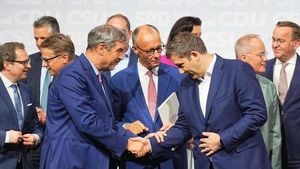The 2025 Sundance Film Festival has once again produced thought-provoking narratives, drawing attention for its more centrist turn as it exposed the audience to politically charged stories at this year’s showcase. The festival, well-known for its liberal stance, seemed to exhibit signs of shifting ideologies, prompting discussions around dialogue and reconciliation across the political divide.
Among the noteworthy presentations was the documentary series 'Bucks County, USA,' which focuses on one of America’s fierce battlegrounds. This five-part docuseries dives deep, examining the chasm created by the recent surge of political tensions, particularly at the school board level, as conservative activist Paul Martino explained during his interview. Featuring personal narratives, the film highlights this divide through the experiences of Martino’s daughter and her best friend, who happens to be the daughter of his political rival.
“It is about all of the post-COVID policies and all of the things…that happened at the school board level once the parents’ rights movement started,” Martino told Fox News Digital, shedding light on the documentary’s range as it addresses real-life situations and tensions. He emphasized the documentary’s aim at fostering conversation, stating, “There is a new openness to dialogue.”
Martino recounted his experience walking around the festival, remarking how attendees appeared more receptive to the film's themes. While he acknowledged the prevalent left-leaning audience, he also noted, “Nobody was closed off to the message,” illustrating the gradually changing atmosphere at Sundance.
The significance of 'Bucks County, USA' becoming an official selection at Sundance didn't go unnoticed. Commenting on its selection, Martino noted, “It appears, in the era of Trump being re-elected, the well-known left-leaning Sundance Film Festival is moving to the middle.” This aligns with the evident struggles around discourse and the pressing need for bridging ideological divides, especially within areas earmarked as political hotbeds.
Yet, not all audience interactions were pleasant for Martino. While there was considerable engagement, he also faced some backlash during the Q&A session following the documentary's screening. “There were questions directed toward me during the session…that were a little bit inflammatory,” Martino recounted. Despite this, he refused to be deterred, humorously registering his disbelief at the apparent misunderstanding of the film's message by parts of the audience. “Did you just watch the movie?” he chuckled, pondering the disconnect.
Accompanying the political narratives was the celebration of historical films with contemporary relevance. One featured film was Gregory Nava’s iconic 1983 drama ‘El Norte,’ which received renewed attention during Sundance. Originally celebrated as the first film featured at the Sundance Directors Lab, Nava expressed hope for its relevance today concerning immigration and border discussions, imparting how audiences still connect deeply with the struggles portrayed on screen.
Reflecting on the distinct impact 'El Norte' had on American policies when it first screened, Nava explained, “It became instrumental in getting the United States to grant protective status to refugees from Central America.” The film's narrative follows two siblings fleeing Guatemala, representing the broader immigrant experience and the harsh realities awaiting many at the U.S. border.
Nava emphasized, “We need to take the humanity of these people with consideration.” His call to embrace compassion echoed throughout the festival, especially against the backdrop of contemporary political landscapes shaped by tough immigration policies. Huerta, who joined Nava at Sundance, has also called for recognizing the indigenous ties to the land, contextualizing contemporary immigration arguments within historical frameworks.
“The indigenous people...are the people who belong to this land,” noted Huerta critically, stressing the need for reevaluated perspectives on immigration. “This is their land, and yet we treat them as if they’re strangers.”
The festival not only curated films like 'Bucks County, USA' and 'El Norte' but also enabled dialogues among filmmakers and audiences. Nava highlighted how independent filmmakers can reflect truth back at power and shine light on systemic injustices. He shared, “We need this now more than ever.” This year’s festival was not just about showcasing films; it was about instigated discussions on social justice, acceptance, and confronting biases.
Sundance’s space for varied narratives signals hope for greater inclusivity within its traditionally liberal stronghold. Paul Martino’s experience at the festival serves as both reflective and indicative of changing tides within film discourse and engagement opportunities aimed at lessening the ideological divide. Encountering dialogue at this year's festival could be seen as pivotal, prompting others beyond its Utah confines to ask themselves: How can narratives of divided experiences lead to more reconciliatory dialogues?
Looking forward, the evolution of Sundance suggests it stands at the intersection of historical significance and contemporary dialogue, shaping the discussions and narratives shared across the globe. With more films focused on bridging divides, the festival may very well be redefining its place within the cinematic community.



